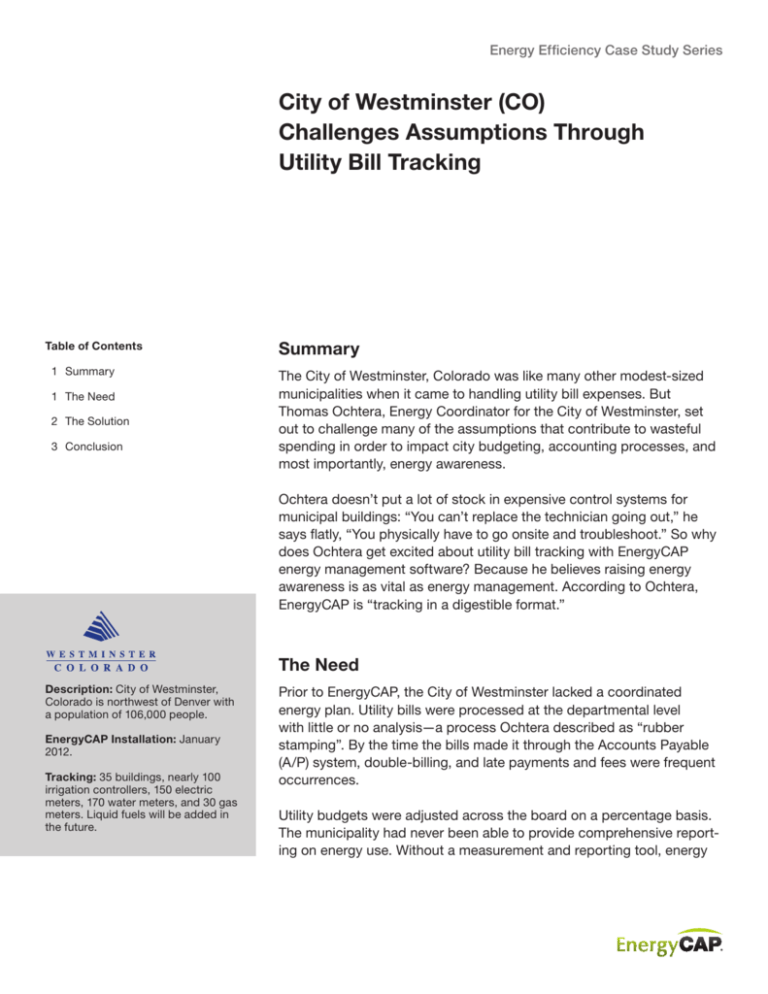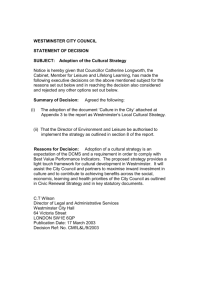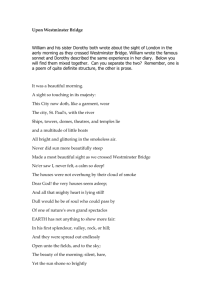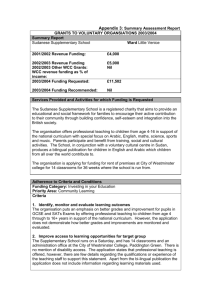
Energy Efficiency Case Study Series
City of Westminster (CO)
Challenges Assumptions Through
Utility Bill Tracking
Table of Contents
Summary
1 Summary
The City of Westminster, Colorado was like many other modest-sized
municipalities when it came to handling utility bill expenses. But
Thomas Ochtera, Energy Coordinator for the City of Westminster, set
out to challenge many of the assumptions that contribute to wasteful
spending in order to impact city budgeting, accounting processes, and
most importantly, energy awareness.
1 The Need
2 The Solution
3 Conclusion
Ochtera doesn’t put a lot of stock in expensive control systems for
municipal buildings: “You can’t replace the technician going out,” he
says flatly, “You physically have to go onsite and troubleshoot.” So why
does Ochtera get excited about utility bill tracking with EnergyCAP
energy management software? Because he believes raising energy
awareness is as vital as energy management. According to Ochtera,
EnergyCAP is “tracking in a digestible format.”
The Need
Description: City of Westminster,
Colorado is northwest of Denver with
a population of 106,000 people.
EnergyCAP Installation: January
2012.
Tracking: 35 buildings, nearly 100
irrigation controllers, 150 electric
meters, 170 water meters, and 30 gas
meters. Liquid fuels will be added in
the future.
Prior to EnergyCAP, the City of Westminster lacked a coordinated
energy plan. Utility bills were processed at the departmental level
with little or no analysis—a process Ochtera described as “rubber
stamping”. By the time the bills made it through the Accounts Payable
(A/P) system, double-billing, and late payments and fees were frequent
occurrences.
Utility budgets were adjusted across the board on a percentage basis.
The municipality had never been able to provide comprehensive reporting on energy use. Without a measurement and reporting tool, energy
1
awareness and management expectations were low. Annual utility
budget increases were routinely tied to utility rate increases, perpetuating two common energy myths:
..Energy costs are a fixed overhead cost.
..Individuals cannot impact energy use.
“Raising energy
awareness is as vital as
energy management.”
Thomas Ochtera,
Energy Coordinator
Ochtera set out to challenge both. “Raising energy awareness is as vital
as energy management,” says Ochtera. “The municipality is not in the
business of making money, but I believe the business model applies.
There are two mistakes that are often made—an assumption that the
engineer who designed the building had energy management in mind.
The second assumption is that there’s nothing that can be done about
energy consumption.” Ochtera wants to challenge these faulty assumptions with energy information.
Using publicly-available RFPs, the city committee tasked with software
acquisition identified the desirable software features and, in the
process, discovered valuable savings opportunities. “Along the way, we
also learned about EDI and how we could save tens of thousands of
dollars in accounting labor before we even saved a kilowatt,” Ochtera
said. The RFP Review committee was the same as the subsequent
software implementation team, so there was good stakeholder buy-in
throughout the RFP process.
The Solution
Centralization of bill processing and integration with the City’s
A/P System. According to Ochtera, EnergyCAP’s A/P integration
capability, along with centralization of the city’s bill processing, will save
$40,000 to $60,000 annually in labor costs alone. Ninety-nine percent
of the City’s bills will be imported to accounting—a decrease from 400
monthly bills entered manually to only six. From there, automated wire
transfer payments will enable Westminster to keep funds in City coffers
longer. “We want the process automated, self-audited, and transparent,” explains Ochtera, “It’s a seamless flow of data from the utility to us
and back to the utility company.”
The Bill Batch report was helpful in providing details on what had been
imported and exported to A/P, including account numbers and relevant
billing data. This information provided the Westminster A/P department
with the blueprint for what should have been going through the new
system. Ochtera says there were hurdles in the EDI implementation,
but he praises the EnergyCAP team: “They’ve really come through
with every one of the promises they made during the RFP stage. We
checked references before we brought them on, and we’ve recommended EnergyCAP to other organizations. It’s a really clever way of
doing energy management.”
2
Issue Tracking. The EnergyCAP Issue Tracker was helpful in resolving
some early issues with electronic bill payment. Using an Issue Tracker
report, Ochtera was able to print out all pertinent data for the utility
providers. With 350 meters to track, the meter-based Issue Tracker
notes were helpful in getting a handle on specific issues from month to
month.
Organized City Portfolio. One difficulty for Ochtera in EnergyCAP
implementation was creating a basic structure of accounts and
buildings in EnergyCAP to accurately model the City’s organizational
features. The City had never organized its portfolio before. According to
Ochtera, “To create a logic tree the first time around was a challenge.
We didn’t have an asset system. We didn’t have a nomenclature for
account codes or place codes. We started using physical addresses.
But what do you do for street lights? We should have been using meter
numbers, and had to switch during implementation.
“It’s important to really take the time to understand the possibilities,”
Ochtera says. “How are we going to handle photovoltaics? Are we
going to submeter? There are many logistical challenges.” But Ochtera
is taking the long view.
Benchmarking charts and reports. For him, the real payoff is the ability to share energy information and benchmark performance to motivate
future energy-saving efforts throughout the City government. About a
quarter of the City’s portfolio is under some level of remote control. The
rest of the buildings have local controls for energy management.
The largest energy consumers are the water treatment facilities, including a reclaimed water facility. There are also two recreation centers with
indoor pools, and two without. There are six fire stations, and two golf
course facilities (clubhouse/restaurant). Other properties include City
Hall, Public Safety, and Municipal Services. Similar use facilities offer
valuable benchmarking and comparison opportunities. EnergyCAP
offers benchmarking charts and reports based on building primary use.
Ochtera is implementing monthly facility reports to help managers
respond to energy management issues in their buildings. The City’s
irrigation system offers a unique benchmarking opportunity, since some
irrigation meters are on a usage-based rate and others are on a fixed
rate. Comparisons provide valuable data for maximizing cost savings
for the City. EnergyCAP is providing summary reporting on the big
picture of City utility use for the first time in Westminster history.
3
Conclusion
With EnergyCAP, the City of Westminster’s energy management program is paying off with more efficient and automated business processes and practices. The software RFP process provided a valuable
education in energy savings opportunities for primary stakeholders in
this municipal government. Faulty assumptions about energy are being
challenged and corrected. The Westminster EnergyCAP implementation
process suggests that an active energy manager committed to using
utility bill tracking as an integral part of an ongoing energy management
initiative can realize short- and long-term energy savings.
Acknowledgement
Thanks to Thomas Ochtera, Energy Coordinator for the City of
Westminster, for his assistance in preparing this Case Study.
EnergyCAP, Inc.
110 Radnor Road, Suite 101
State College, PA 16801
© 2012 EnergyCAP, Inc. All rights reserved.
877.327.3702
www.EnergyCAP.com
sales@EnergyCAP.com
4
v1.1
Westminster, Colorado
Defeats Energy Myths
THROUGH UTILITY BILL TRACKING
Before E n e r gyCAP....
Bills were processed with
minimal analysis—a process
known as “rubber stamping”.
PAID
D
PAI
PA
ID
PAID
The City of Westminster lacked a
coordinated energy plan.
This perpetuated 2 common energy myths:
MYTH 1:
ENERGY COSTS ARE A
FIXED OVERHEAD COST
MYTH 2:
INDIVIDUALS CANNOT
IMPACT ENERGY USE
$
Thomas Ochtera,
“Raising energy
awareness is as
vital as energy
management!”
ENERGY COORDINATOR
FOR THE CITY OF WESTMINSTER,
set out to challenge
these assumptions with
energy information.
Energy C o o r dinator
t ra l i zat i o n
s i ng
s
e
Ce n
c
of B ill P ro
g
e
t
r
n
a
I
t
’s A/P Syste m
i
on w i
&
y
t
i
th the C
EnergyCAP’s A/P integration capability,
along with centralization of the City’s
bill processing, will save $40,000–$60,000
annually in labor costs alone.
I s sue
Track i ng
Issue Tracker notes were
helpful in getting a handle
on specific issues from
month to month.
O r g n ized City
a
P o r t f o l io
EnergyCAP helped create a basic
structure of accounts and buildings
to accurately model the City’s
energy use and cost.
Bench mark i
n g C h arts
& Re p o r t s
EnergyCAP is providing summary
reporting on the big picture of
City utility use for the first time
in Westminster history.
THE CITY OF WESTMINSTER
tracks:
35
BUILDINGS
100
IRRIGATION
CONTROLLERS
150 170 30
ELECTRIC
METERS
WATER
METERS
GAS
METERS
Westminster’s energy management program is paying off with
more efficient and automated business processes.
©2012 EnergyCAP, Inc.
www.EnergyCAP.com






